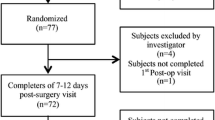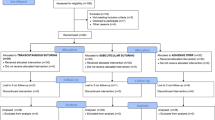Abstract
Objective
To analyze the effectiveness of skin adhesives and sutures in the closure of laparoscopic port-site wounds.
Methods
Electronic databases were searched to find relevant randomized controlled trials and their data was analyzed to generate a summative outcome.
Results
Seven trials on port-site wound closure after laparoscopic procedures encompassing 902 patients were retrieved from the electronic databases. Four randomized controlled trials on 404 patients qualified for the review according to inclusion criteria. In both fixed- and random-effects models, there was no difference between the two port-site wound closure techniques in terms of wound infection, wound dehiscence and, patient satisfaction. However, statistically tissue adhesives were quicker in port-site wound closure as compared with sutures.
Conclusions
Based on this review, there is insufficient evidence that port-site wound closure technique by tissue adhesives is superior to traditional suture closure technique in terms of wound infection, wound dehiscence, and patient satisfaction. However, tissue adhesives are quicker in port-site wound closure. A multicentre randomized controlled trial is required in order to obtain stronger evidence.





Similar content being viewed by others
References
Quinn J, Wells G, Sutcliffe T, Jarmuske M, Maw J, Stiell I, Johns P (1997) A randomized controlled trial comparing octylcyanoacrylate tissue adhesive and sutures in the management of lacerations. JAMA 277:1527–1530
Maw JL, Quinn JV, Wells GA, Ducic Y, Odell PF, Lamothe A, Brownrigg PJ, Sutcliffe T (1997) A prospective comparison of octylcyanoacrylate tissue adhesive and suture for the closure of head and neck incisions. J Otolaryngology 26:26–30
Quinn J, Wells G, Sutcliffe T, Jarmuske M, Maw J, Stiell I, Johns P (1998) Tissue adhesive versus suture wound repair at 1 year: randomized clinical trial correlating early, 3 month and 1 year cosmetic outcome. Ann Emerg Med 32:645–664
Bruns TB, Robinson BS, Smith RJ, Kile DL, Davis TP, Sullivan KM, Quinn JV (1998) A new tissue adhesive for laceration repair in children. J Paediatrics 277:1527–1530
Singer AJ, Hollander JE, Valentine SM, Turque TW, McCuskey CF, Quinn JV (1998) Prospective, randomized, controlled trial of tissue adhesive (2-octyl cyanoacrylate) vs standard wound closure techniques for laceration repair. Acad Emerg Med 5:94–99
Vanholder R, Misotten A, Roels H, Matton G (1993) Cyanoacrylate tissue adhesive for closing skin wounds: a double blind randomized comparison with sutures. Biomaterials 14:737–742
Mizrahi S, bickel A, Ben-Layish E (1988) Use of tissue adherence in the repair of lacerations in children. J Paediatr Surg 23:312–313
Keng TM, Bucknall TE (1989) A clinical trial of histoacryl in skin closure of groin wounds. Med J Malaysia 44:122–128
Coover HN, Joyner FB, Sheerer NH (1959) Chemistry and performance of cyanoacrylate adhesive. In: Special Technical Papers. vol 5, pp 413–417
Yaron M, Halperin M, Huffer W, Cairns C (1995) Efficacy of tissue glue for laceration repair in an animal model. Acad Emerg Med 2:259–263
Dowson CC, Gilliam AD, Speake WJ, Lobo DN, Beckingham IJ (2006) A prospective randomized controlled trial comparing n-butyl cyanoacrylate tissue adhesive (Liquiband) with sutures for skin closure after laparoscopic general surgical procedures. Surg Laparosc Endosc Percutan Tech 16:146–150
Egger M, Smith GD, Altman DG (2006) Systematic reviews in healthcare. BMJ, London
Deeks JJ, Altman DG, Bradburn MJ (2001) Statistical methods for examining heterogeneity and combining results from several studies in meta-analysis. Systemic reviews in health care: meta-analysis in context, 2nd edn. BMJ, London
Sebesta MJ, Bishoff JT (2004) Octylcyanoacrylate skin closure in laparoscopy. JSLS 8:9–14
Jallali N, Haji A, Watson CJ (2004) A prospective randomized trial comparing 2-octyl cyanoacrylate to conventional suturing in closure of laparoscopic cholecystectomy incisions. J Laparoendosc Adv Surg Tech A 14:209–211
Matin SF (2003) Prospective randomized trial of skin adhesive versus sutures for closure of 217 laparoscopic port-site incisions. J Am Coll Surg 196:845–853
Harold KL, Goldstein SL, Nelms CD, Matthews BD, Sing RF, Kercher KW, Lincourt A, Heniford BT (2004) Optimal closure method of five-millimeter trocar sites. Am J Surg 187:24–27
Maartense S, Bemelman WA, Dunker MS, de Lint C, Pierik EGJM, Busch ORC, Gouma DJ (2002) Randomized study of the effectiveness of closing laparoscopic trocar wounds with octylcyanoacrylate, adhesive papertape or poliglecaprone. Br J Surg 89:1370–1375
Qureshi A, Drew PJ, Duthie GS, Roberts AC, Monson JR (1997) n-Butyl cyanoacrylate adhesive for skin closure of abdominal wounds: preliminary results. Ann R Coll Surg Engl 79:414–418
Emori TG, Gaynes RP (1993) An overview of nosocomial infection, including the role of the microbiology laboratory. Clin Microbiol Rev 6:428–442
Malone DL, Genuit T, Tracy JK (2002) Surgical site infections: reanalysis of risk factors. J Surg Res 103:89–95
Raka L, Krasniqi A, Hoxha F, Musa R, Liamini D, Tolaj I (2008) Surgical site infections in an abdominal surgical ward at Kosovo Teaching Hospital. World Hosp Health Serv 44:32–36
Bandyk DF (2008) Vascular surgical site infection: risk factors and preventive measures. Semin Vasc Surg 21:119–123
Ward VP, Charlett A, Fagan J, Crawshaw SC (2008) Enhanced surgical site infection surveillance following caesarean section: experience of a multicentre collaborative post-discharge system. J Hosp Infect 70:166–173
Khan MN, Fayyad T, Cecil TD, Moran BJ (2007) Laparoscopic versus open appendectomy: the risk of postoperative infectious complications. JSLS 11:363–370
Greene D, Kock RJ, Goode RL (1999) Efficacy of octyl-2-cyanoacrylate tissue glue in blepharoplasty. Arch Facial Plast Surg 1:292–296
Ozutran O, Miman MC, Aktas D, Oncel S (2001) Butylcyanoacrylate tissue adhesive for columellar incision closure. J Laryngol Otol 115:535–540
Shamiyeh A, Schrenk P, Stelzer T, Wayand WU (2001) Prospective randomized blind controlled trial comparing sutures, tape, and octylcyanoacrylate tissue adhesive for skin closure after phlebectomy. Derm Surg 27:877–880
Coulthard P, Worthington H, Esposito M, van der Elst M, van Waes OJF (2002) Tissue adhesives for closure of surgical incisions. Cochrane Database Syst Rev 2002, Issue 3. Art. No.: CD004287. doi:10.1002/14651858.CD004287
Author information
Authors and Affiliations
Corresponding author
Rights and permissions
About this article
Cite this article
Sajid, M.S., Siddiqui, M.R., Khan, M.A. et al. Meta-analysis of skin adhesives versus sutures in closure of laparoscopic port-site wounds. Surg Endosc 23, 1191–1197 (2009). https://doi.org/10.1007/s00464-009-0373-y
Received:
Revised:
Accepted:
Published:
Issue Date:
DOI: https://doi.org/10.1007/s00464-009-0373-y




